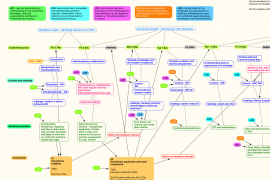At Sydney, almost all units of study use a graded system for assessment; that is students’ work is assessed as being on the scale of 0-100% divided commonly into merit grades: High Distinction (HD), Distinction (DI), Credit (CR), Pass (PS) and Fail (including Absent Fail to indicate non-completion of a mandatory part of the assessment). Many of us take this system for granted, and don’t question whether grading is always a fair, sensible, or helpful way to assess student learning. However, there is evidence that using a “pass/fail” system might have benefits, particularly in first year units and units that have learning outcomes predominantly focused on skills and competencies, such as those in the Open Learning Environment (OLE).
A brief history
Interestingly, before the late 18th century it seems that grading wasn’t a common practice. Bowen and Cooper (2022) report that Harvard and Yale used family status as a way to rank students up until around 1814. After that there was a gradual introduction of student ranking in American institutions based around performance, with the introduction of grading on a curve with a normal distribution becoming more common from the 1930s onwards (Corey, 1930, in Bowen and Cooper, 2022). In the UK, ranking based on perceived merit in oral and written exams seems to have been common from around the late 1700s.
Reasons to not grade
In the book “Ungrading: Why rating students undermines learning (and what to do instead)”, Susan Blum and others look at the negative effects of grading on students and learning. Key arguments in the book are that grades do not serve as effective motivators for students. They often promote incorrect values, prioritising the products of assessment over the process of learning and development of understanding. They argue that grades may not accurately represent learning progress. Instead, grades actually frequently reflect a student’s ability to stick to guidelines and regurgitate information, rather than the extent of their learning. Grades fail to capture the unique, subjective, and often emotional nature of learning. A systematic review of the literature of reduced grading by Normann et al., (2023) showed that there is little evidence to suggest that getting a low grade prompts students to try harder.
The authors also argue that grades do not provide constructive feedback. They oversimplify complex tasks by reducing them to numerical values (like 8/10, 85%) and at the same time, they become overly complex, providing too many variations that can be confusing.
Additionally, they argue that grading can foster a competitive environment rather than a collaborative one. Even seemingly benevolent practices like grading on a curve or norming, actually intensify competition by making students (and occasionally teachers) compete against each other. This can manifest itself in many ways, including extended discussions with markers on the marks awarded and the marks deducted rather than how to improve the work.
What does the literature tell us about using pass/fail grading?
There are a number of studies that have looked at units with pass/fail grading, and the benefits it can have. These studies are mainly from medical education and health sciences, with some studies in other areas of STEM.
To reduce stress and anxiety
One significant advantage of pass/fail grading is its potential to reduce stress and anxiety among students. Spring et al., (2011) conducted a systematic search of the literature over a 30 year period and found that pass/fail grading improved students’ feelings of anxiety. This is crucial for first-year students who are often transitioning to a new and challenging academic environment. By removing the pressure associated with traditional grading systems, pass/fail evaluation can create a more supportive learning environment that allows students to focus on their studies without excessive worry about grades. Another study from medicine (Bloodgood et al. ,2009) suggests that implementing a pass/fail grading system led to enhanced student satisfaction and improved well-being. The study highlights that the shift to a pass/fail system offered specific benefits to medical students, boosting their psychological well-being and satisfaction without compromising their academic performance.
To improve equity
Furthermore, pass/fail grading can provide a more equitable assessment approach for students with diverse academic backgrounds. White & Fantone, (2009) found that for first-year university students, who may come from varied educational settings, a pass/fail system can help level the playing field and ensure that all students have an equal opportunity to succeed. Another study looking at first year pharmacy education found that implementing a pass/fail system significantly reduced stress, increased group cohesion and improved academic outcomes (Spiess et al., 2022). Bowen and Cooper (2021) argue that the idea of grading on a curve assumes that students’ abilities are spread out in a normal distribution. This perspective overlooks the fact that social and cultural factors also influence student performance. It’s crucial to remember that various life factors determine who gets to go to university and who doesn’t, for example, systemic racism might affect the chances and success of equity groups such as First Nations people, people living with a disability and others. Moreover, some students go to underfunded and understaffed schools where they have limited exposure to subjects like advanced mathematics. Hence, the concept of an “average” student isn’t realistic, especially in the diverse classrooms of the 21st century, where students have unique needs and backgrounds.
To encourage mastery of skills
In the context of engineering, science, and humanities disciplines, there is evidence supporting the effectiveness of pass/fail grading systems in assessing student achievement, particularly in courses that focus on skills and competencies. Research in engineering education has explored the benefits of pass/fail grading in ensuring that students meet critical competencies, which is especially relevant for professional programs like engineering (Zhuang et al. 2022). Additionally, studies have highlighted the use of standards-based grading in engineering courses as a means to assess student performance based on defined learning objectives and competencies (Post, 2017; Mendez, n.d.). White and Fantone (2009) found that pass/fail grading systems might encourage students to focus on mastering the subject matter rather than merely striving for high grades. This shift in focus can lead to a deeper understanding of the course material and can promote lifelong learning habits.
A quantitative analysis by Kjærgaard et al (2023) found that gradeless learning can improve students’ motivation and reduce surface learning at the same time as having no significant negative effect on student’s later academic achievements. They found that gradeless courses enabled students to focus more on soft skills and that students were more comfortable in engaging in collaborative work.
The case for pass/fail units at Sydney
At Sydney, “pass/fail” units return a grade of “Satisfied Requirements” (SR) or “Failed Requirements” (FR). These grades are recorded on the students’ transcripts but are not included in the Weighted Average Mark. According to Schedule 1 of the Coursework Policy, in these units “student achievement is measured as a pass or fail only without a mark to students who, in their performance in assessment tasks, demonstrate the learning outcomes for the unit at an acceptable standard as defined by grade descriptors or exemplars established by the faculty”. This is an important definition. While ‘pass’ is used in both systems, in the graded system it means that a student somehow accumulated 50 marks, without addressing any specific learning outcome. By contrast, in the ungraded system, it means that the learning outcomes have been met satisfactorily. So a pass in one may not constitute a pass in the other. Naturally, assessments in the ungraded system need to reflect the need for students to demonstrate satisfactory or unsatisfactory attainment of learning outcomes. Most current assessment tasks are not structured in this way (Schmid et al., 2018). In 2024, students are enrolled in 538 such units compared to 4827 units which return both grades and marks, with total enrolments of around 31000 and 471000 students respectively. The table below shows the breakdown across the University.
Table 1: Number of pass/fail units (with total enrolments in parenthesis) by faculty and level in 2024. Only units with non-zero enrolments have been included.
| Faculty | Level | Overall | ||||
|---|---|---|---|---|---|---|
| 1000 | 2000 | 3000 | 4000 | Postgraduate | ||
| Arts and Social Sciences | 5 (46) | 21 (1643) | 22 (395) | 49 (1158) | 121 (3389) | 219 (6644) |
| Business | 1 (16) | 2 (126) | 0 (0) | 0 (0) | 32 (994) | 35 (1136) |
| Engineering | 4 (5042) | 3 (2671) | 2 (1346) | 1 (26) | 1 (148) | 21 (9932) |
| Medicine and Health | 1 (25) | 1 (86) | 13 (1422) | 17 (800) | 74 (4229) | 116 (6601) |
| Science | 0 (0) | 9 (288) | 1 (83) | 0 (0) | 48 (3336) | 67 (4127) |
| Conservatorium of Music | 0 (0) | 3 (50) | 5 (9) | 13 (224) | 6 (26) | 29 (550) |
| Law School | 2 (364) | 0 (0) | 1 (54) | 0 (0) | 3 (272) | 6 (690) |
| Architecture, Design and Planning | 1 (496) | 14 (68) | 12 (79) | 6 (37) | 12 (166) | 45 (846) |
| Total | 14 (5989) | 53 (4932) | 56 (3388) | 86 (2245) | 285 (12560) | 538 (30526) |
In 2023, 3.7% of students received a fail (FR) grade in these units – around half the fail rate of students in units with both marks and grades. Students satisfaction is also higher in these units with a mean of Q1-6 in the Unit of Study Survey (USS) of 4.32 compared to 4.24 in other units in 2023. This higher satisfaction is reported for all levels.
Perhaps there is room for further conversations about certain units being pass/fail; in particular OLE units, which often focus on skills, and perhaps some other first year units?
Tell me more
- This blog has some interesting ideas and links to further reading about ungrading https://lile.duke.edu/blog/2022/09/what-is-ungrading/
- Joanh Dunch talks about the case for going gradeless in Canadian universities https://macleans.ca/education/its-time-for-canadian-universities-to-go-gradeless/
- Read about assessment load at Sydney






1 Comment